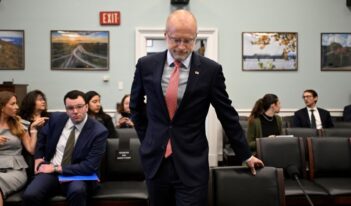
Would the FTC be an effective body for regulating Internet openness?
When it comes to the current net neutrality debate, it is fair to say that we face either Groundhog Day or D-Day.
In other words, the current debate could play out as did previous iterations: the Federal Communications Commission (FCC) approves an order, the order is challenged in court, and the issue is settled before the U.S. Court of Appeals for the D.C. Circuit. This is the Groundhog Day scenario. It is familiar and well understood.
Alternatively, we may see a different outcome in the form of a legislative fix and a final resolution to this protracted issue. This different outcome could be the D-Day scenario.
Of course, either scenario promises full employment for lobbyists and advocates on both sides of the net neutrality debate in the coming weeks and months.
The legislative path to net neutrality—the D-Day scenario—is the road less traveled and is worth exploring since, in theory, it allows an opportunity for a lasting resolution. For those on the pro-neutrality side of the ledger, legislation would need to look awfully close to the FCC’s 2015 net neutrality order for it to garner their support.
For net neutrality proponents, legislation that is serious about the issue should include a ban on blocking, throttling, and paid prioritization for lawful content. These bright-line rules should apply no matter how a consumer chooses to access content, whether from a fixed or mobile device. The legislation should also be future-proofed in order to capture conduct that may arise down the road which would violate the letter and spirit of net neutrality. The backstop on these rules should be the expert agency, namely the FCC.
Time will tell whether these principles are too much to ask of Internet service providers (ISPs), such as AT&T and Comcast. On the one hand, they have run expensive ad campaigns in past months espousing their support for net neutrality. On the other hand, they have submitted filings to the FCC arguing that net neutrality is a solution in search of a problem.
In the D-Day scenario, the devil would lie in the legislative detail. It would also require Democratic support in order to pass successfully through the Senate.
Another newer and less debated path supported by several ISPs is to move net neutrality away from the FCC to another forum entirely, namely the Federal Trade Commission (FTC). For the sake of argument, we can refer to this path as Plan B for the ISPs. This FTC path is less defined than the better-worn paths leading to the FCC, the courts, and the U.S. Congress. Still, absent a legislative solution to net neutrality, a careful reading of the ISPs’ recent FCC filings reveals that it may well become their Plan B. Significantly, there are some indications that at least some members of the FCC and FTC may support Plan B.
What exactly does Plan B look like? The precise contours are not entirely clear, but piecing together snippets from various filings, law review articles, and speeches, the following theoretical contours emerge:
- The FCC would reclassify broadband Internet access as something other than a Title II common carrier service. This would lift the bar against the FTC’s ability to regulate common carriers since the Federal Trade Commission Act specifically excludes the FTC from exercising such authority over telecommunications providers.
- The FTC would then step into the fray and assert jurisdiction under its general authority to police unfair and deceptive acts and practices and unfair methods of competition affecting commerce—commonly known as its Section 5 authority.
- Under Section 5, ISPs would include in their terms and conditions voluntary commitments to consumers not to block or throttle their content. These promises would be policed by the FTC using its enforcement authority over unfair or deceptive acts and practices.
- Other components of net neutrality—such as paid prioritization—could be handled by the FTC under its authority to police unfair methods of competition under the antitrust laws. Under this scenario, the FTC could police what some ISPs refer to as “anticompetitive paid prioritization,” the kind of prioritization that does not enhance consumer welfare as defined by the antitrust laws.
For proponents of strong net neutrality protections, Plan B raises a couple questions. Are its protections equal to the benchmark established in the FCC’s 2015 order? And if not, why not?
Absent a full blueprint, a few important procedural and substantive differences between the FCC’s 2015 net neutrality order and what we know about Plan B come to mind.
Although many refer to the FTC as a regulator in the same vein as the FCC, the FTC is in fact a law enforcement agency with quasi-regulatory authority over several sectors of the economy—although, ironically, not the telecommunications sector, from which it has mostly been excluded from regulating since its inception. Unlike the FCC, the FTC would only step into the fray once a net neutrality violation allegedly occurs. Also, unlike the FCC’s bright-line rules forbidding blocking, throttling, and paid prioritization, issued before the alleged violation already occurs, the FTC would have to wait for conduct to occur, wait for a complaint from an affected consumer, and only then possibly decide whether to enter the picture and open an investigation.
Similarly, should a start-up firm affected by so-called anticompetitive paid prioritization want to pursue a complaint against an ISP, the start-up will have to persuade the FTC to open an investigation and pursue costly antitrust litigation over several years. For many start-ups, this costly and time consuming path is untenable when compared to the bright-line rule banning paid prioritization in the 2015 FCC order. The 2015 rules provide start-ups with the regulatory certainty needed to get off the ground. In contrast, antitrust litigation creates red tape and casts doubt over start-ups’ ability to attract investment.
In light of these procedural differences, it is hard to see how net neutrality at the FTC aligns with the FCC’s 2015 order. But what of the substance? How would net neutrality protections fare under the FTC’s Section 5 authority?
For an answer to this question, it is instructive to look to a 2011 speech by then-FTC Commissioner J. Thomas Rosch. In his speech, Rosch analyzed net neutrality protections under the antitrust laws and asked whether the FTC would be qualified to enforce them. Importantly, Rosch was a highly regarded and experienced antitrust trial lawyer; he was also a Republican.
In his 2011 speech, Rosch spoke at length about why he did not believe that the FTC either should or could police net neutrality. Although he acknowledged that a framework similar to Plan B could be strung together in theory, Rosch argued that to put this framework into practice at an enforcement agency like the FTC, more than theory would be needed. He concluded that “successful antitrust enforcement requires more than theories; both the facts and the law must be arguably on our side.” On both the facts and the law, Rosch found the FTC lacking in what would be needed to police net neutrality protections under the antitrust laws.
Should the current net neutrality legislative process stall out and Plan B come to the forefront of the policy agenda, the question for net neutrality proponents must therefore be: is the FTC up to the task?
The photograph of the statue outside the Federal Trade Commission’s building has been altered for size and is used under a Creative Commons license.




